MYP digital design comes in many forms. Website design, game design, and coding are some examples. This MYP digital design unit evolved from working with Year 1 (sixth-grade) students at the American School of Lima in Peru, South America from 2015 to 2019.
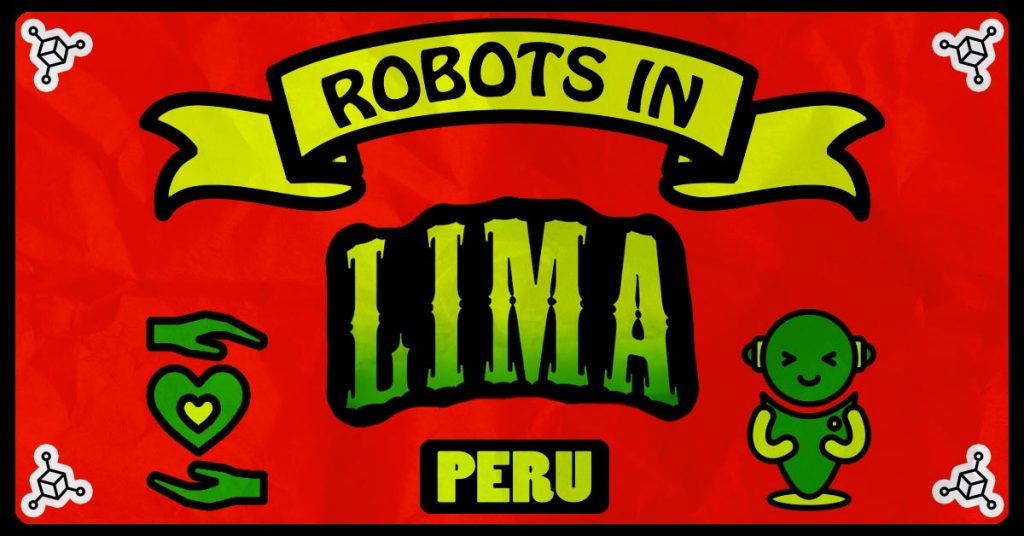
The rich cultures of Peru inspired our unit! With this MYP digital design example, students wrapped up their design year by exploring:
- the role of artificial intelligence
- spatial thinking
- culture
- color theory
- empathy
- typography
We called our unit Robots in Action. This MYP digital design lesson offers educators interdisciplinary (IDU) opportunities to provide students with a more holistic and meaningful learning experience.
Use and modify these free design resources with a focus on your student’s communities. A link back to VistaThink is always appreciated!
What is MYP Design?
MYP Design is part of the International Baccalaureate® (IB) education program. MYP stands for Middle Years Program and serves students in grades six through ten. In MYP Design, students learn to apply practical and creative thinking skills to solve a wide range of design problems. Teachers have lots of choices for design units in the MYP. This paradox of choice of topics can be both helpful and overwhelming!
MYP Design is a form of project-based learning. In both approaches to learning, students work on a project over an extended period. The interdisciplinary experience allows students to apply knowledge and skills from different subject areas. MYP Design and project-based learning emphasize student-centered learning, collaboration, and real-world problem-solving.
The MYP’s global focus naturally encourages real-world problem-solving in MYP Design to be more culturally responsive. Compared to traditional project-based learning, MYP Design will incorporate cultural perspectives, practices, and values into the curriculum. MYP Design units promote diversity and equity and the underrepresentation of marginalized groups, such as women and Indigenous peoples. This Robots in Action unit asks students to think about who has the greatest need in their city and to try to help that group.
What is Digital Design in MYP?
Digital design, like physical design, uses the MYP Design Cycle to guide students through a comprehensive problem-solving process. Students learning design create computer-generated digital products that target a problem for specified client/target audience. Experiences with design technology facilitate the development of design literacy.
What is the MYP Design Cycle?
Sometimes called the IB Design Cycle, the MYP Design Cycle guides students through a comprehensive problem-solving process. The sequential steps empower students to develop the best solution for their client/audience.

MYP digital design with 3D Tinkercad robots is fun and engaging, allowing kids to go off-script and show off their digital design skills. The unit involves lots of creative conceptualization and technical complexity. It would not be a unit to start MYP Design with Year 1 students and functions better to close out the year. Even with more experienced MYP Design students, beginning the school year with a more well-defined approach to the design process is best. For example, a more straightforward engineering unit would be better for an introduction into MYP Design.
GRASPS Model Example
The Wiggins and McTighe GRASPS model outlines the essential elements of the unit while adding authenticity to the experience:
- Goal – You will design a robot prototype with 3D software. The intended function of the final robot is to help people in the neighborhoods of Lima, Peru. You will also create a presentation about the robot and its service capabilities within a Lima community.
- Role – You are a futurist and visual designer hired by the city of Lima to create a culturally relevant and empathetic robot prototype to help people in Lima, Peru. Some examples of the areas of service are care for older adults, social buddy, K-12 education, community building, law enforcement, medical services, transportation services, health and wellness, infrastructure maintenance, traffic management, search & rescue, entertainment, job training, etc.
- Audience – Your immediate client is the city government of Lima. Your eventual audience are the residents of a Lima neighborhood.
- Situation – The city of Lima’s mission is to help its citizens thrive, and robots are part of the plan. Regardless of people’s perceptions, modern robots are coming to Lima! But to do what? How will they help people? Will they function as aides, companions, friends, co-workers, lawyers, authority figures, schoolmates, counselors, or… something or someone else? You will design Lima’s first robot prototype to work with a small or large population of people and create informational material that explains the robot’s role and function in the community.
- Product – You will create a digital 3D robot prototype and a corresponding presentation to explain its essential functions.
- Standards for Success – Your digital robot prototype shall:
- look humanoid
- look like its primary purpose (e.g., senior care worker, pet care provider, social companion, etc.)
- incorporate aspects of Peru’s Cultura Chicha for community integration
- base its service function(s) on empathy
The browser-based application Tinkercad is used to design the digital 3D robots. Toward the end of the unit, we printed models that were accurately sized and configured.
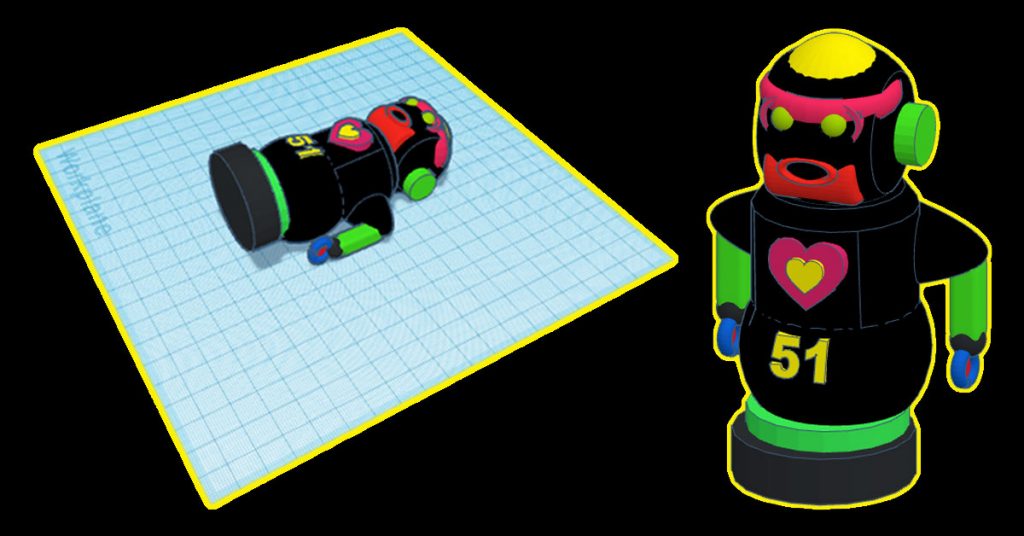
Students used Google Slides to present their prototypes in an elevator pitch/PechaKucha style. By this point in the school year, students knew the basics of Adobe Photoshop to help with some of the graphic design. However, Photoshop is optional for creating the visuals for the presentations in Criterion C.
What is La Cultura Chicha?
Peru’s Cultura Chicha is represented in music and art with a rich history and an evolving, modern expression. Lesley University in Massachusetts shares an in-depth and knowledgeable article about Cultura Chicha. I love this quote from the author because it inspires the spirit of this MYP digital design lesson:
Even though the separation of classes still heavily defines Lima’s society today, it is both Chicha music and Chicha art that has manifested itself as being wholly “Peruvian,” while maintaining its status as the aural and visual representation of the working class.
Lesley University
Chicha music is the fusion of Afro-Peruvian music and cumbia. It comes from the working class in Peru and is very popular. The traditional sound is created by guitars, drums, and accordions. This music has become more mainstream in Peru because it has been embraced by many new artists.
During sketching and Criterion C build time, we would enjoy music from El Chacalón y la Nueva Crema. El Chacalón (Lorenzo Palacios Quispe) rose from poverty in the 1980s to become a famous Peruvian cumbia singer and songwriter.
One of the main reasons that this music has become so popular is because it’s seen as a way to express oneself freely. The lyrics are often about love and poverty, which are topics that people can relate to easily. The neon fluorescent vibe of Chicha art with its big, bold typography is also a way for people to express themselves visually (and easily) without being too explicit or politically charged.
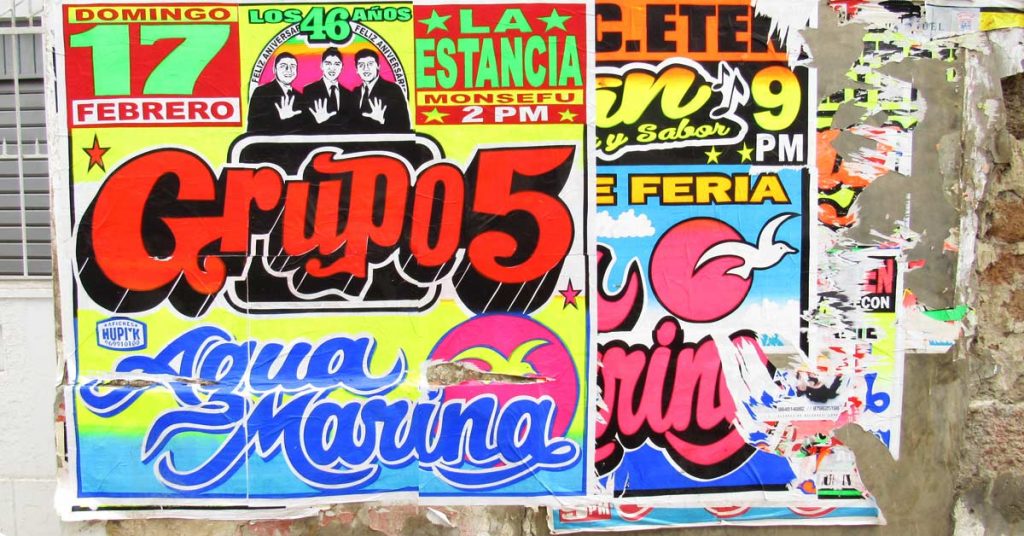
Working with Tinkercad in MYP Digital Design
MYP digital design is a natural fit with 3D modeling! Students created their robots with Tinkercad, a free, web-based software used to create 3D designs. The app has an intuitive interface that is easy to learn and use. A mouse helps with navigation, creating, and editing. Trackpad navigation is more difficult.
Tinkercad tutorials are available online for beginners who are new to the software. There are also in-depth tutorials on how to use the software for more advanced designs. Students can create almost anything they want with this software. Keychains, jewelry, and even modern jet models are options. Tinkercad includes a 3D modeling software library of shapes and an online community of model contributors.
Teachers can set up classes and invite students to join via a class code. Students log in to Tinkercad with their Google accounts. Tinkercad also integrates with Google Classroom. If you’re looking for standards alignment, the lesson plans offered by Tinkercad integrate with ISTE, NGSS, and Common Core.
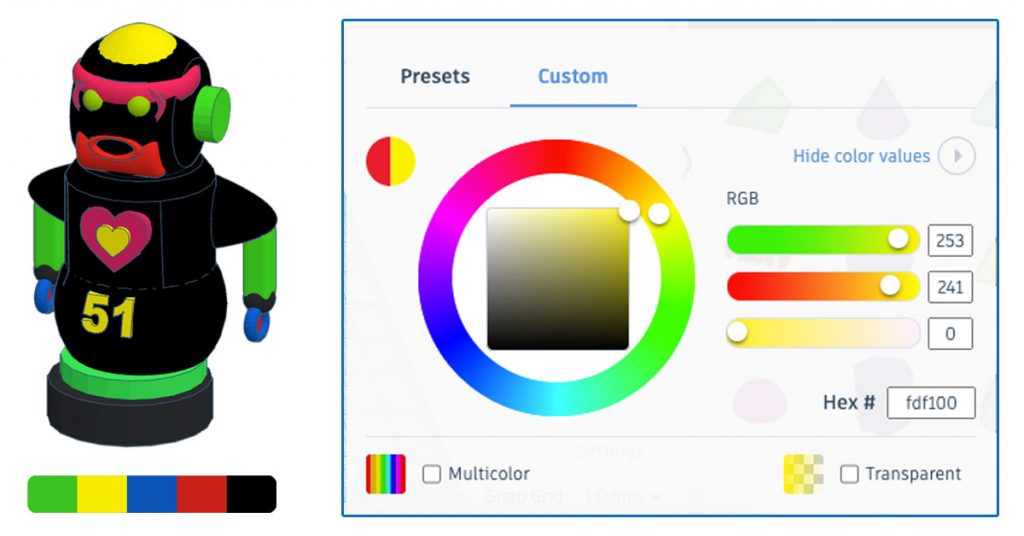
Coloring Models
Tinkercad’s custom color choices can produce precise Cultura Chicha colors. There are many free online apps to extract hex values from the array of Chicha images online. Canva is fast, requiring no login, but only yields four colors. Copying the hex value right from the swatch is a nice feature.
Adobe Color is also free, and no login is required. Go to the Extract Theme menu option, then upload an image to extract its colors. After I uploaded a screenshot of a Cultura Chicha poster from Google Street View, the app pulled five colors, and copying hex values was super intuitive. Moving around the color-pick-up circles over the image to generate new color choices and playing with moods can inspire the palette.
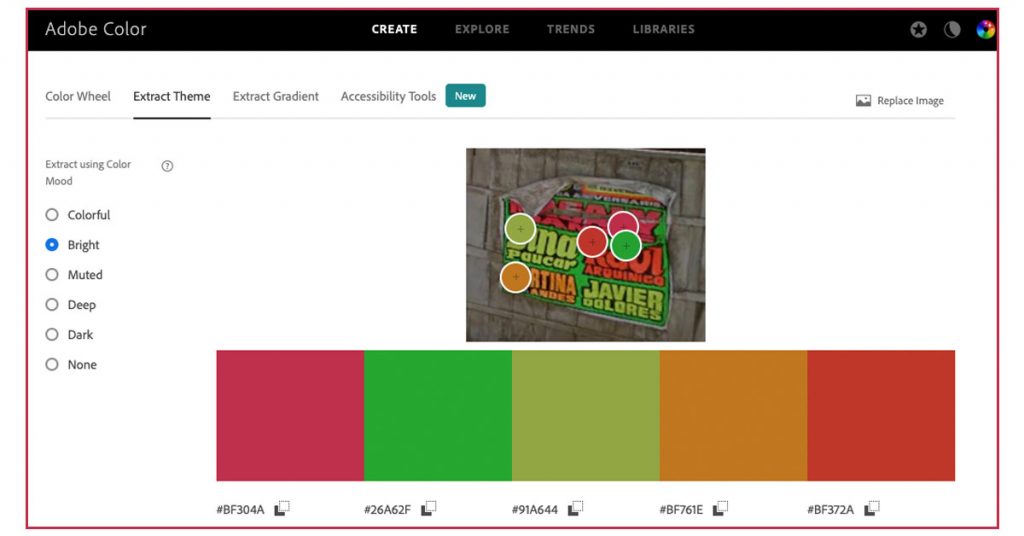
MYP Digital Design Unit Plan
I prefer a unit plan with the basic elements to focus on the essentials for students. Your IB MYP Coordinator may require a more comprehensive array of lesson components. The IB’s Evaluating MYP Unit Planners guide outlines the elements of a unit planner for the MYP if you need more details.
Although not an official component of an MYP Design Unit Plan, start with the GRASPS, and let the student questions come. Once students are familiar with the nature of the lesson, work your way into MYP Design Criterion A – Inquiring and Analyzing.
Presenting and discussing the Statement of Inquiry and Inquiry Questions adds authenticity to the purpose of your student’s efforts in the unit. For some units, inquiry questions may fit naturally into Criterion A, and may deserve a revisit in Criterion D.
Key Concept
- Communities and Systems
Related Concepts
- Innovation, Function, Perspective
Global Context
- Personal and Cultural Expression
Statement of Inquiry
- The function of a system relates to the environment in which it operates.
Inquiry Questions
- Factual Question – What different jobs can robots do?
- Factual Question – What major parts do most robots have?
- Conceptual Question – How does the form/shape of a robot relate to its function?
- Conceptual Question – How does the form/shape of a robot relate to its environment?
- Debatable Question – Why do robots need to help humans in empathetic ways?
Criterion A – Inquiring and Analyzing
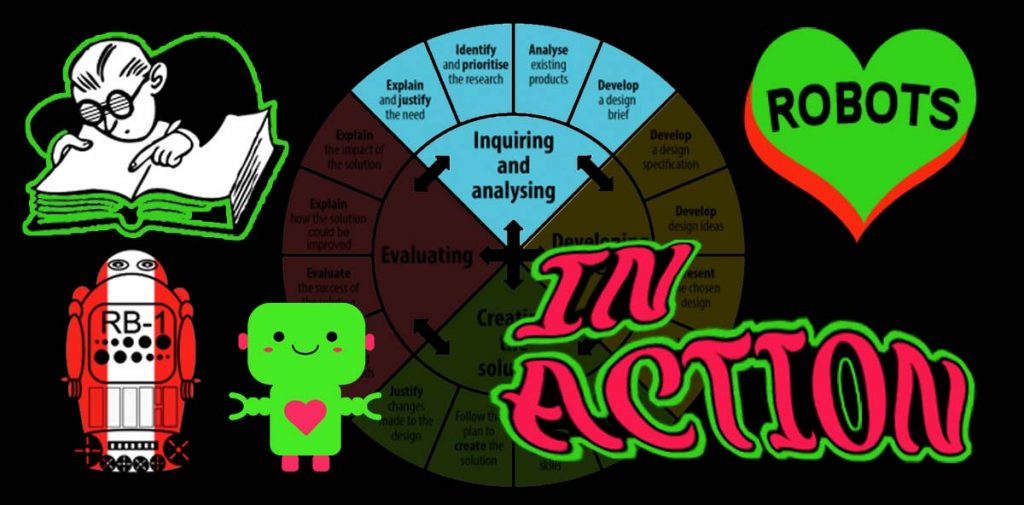
During Criterion A, students practiced sketching, which helps with the Criterion B requirements. Sketching can be physical (e.g., pencil) or digital. For MYP digital design with Tinkercad, students should practice making 3D objects. Adding, moving, resizing, aligning, and subtracting basic shapes are essential skills. So spend about one-third of the class during Criterion A sketching in Tinkercad. If that is too much time just for Tinkercad, allow for pencil sketching of humans. I tended to put focus on the human face and head.
Much of Strand A.1 – Explain and Justify the Need restates the GRASPS. Criterion A, at least for Year 1 students, can be unappealing if research-heavy. Making the experience hands-on helps build interest and engagement. For this MYP Digital design example, hands-on could mean chatting with a bot.
Chat Bots for Kids
ChatGPT can write original works, computer code, and music. It’s got lots of potential to be helpful. However, is it too helpful for schools? Note: When I signed up with a personal Google account in 2023, it required a phone number. It can also report that it’s at capacity, so plan ahead when using it in a lesson.
Engadget reported in January 2023 that NYC schools had blocked ChatGPT for fear that it would facilitate cheating and limit critical thinking. In contrast, high school teacher David Cutler summed up our lives as educators with AI: We need to guide students to use AI ethically and effectively, and we’re just getting started…
Free Chat Bot
In my classes, I was using the free Mitsuku chatbot with my students for research (pre generative AI time period). Mitsuku won the now-defunct Loebner Prize multiple times. This award was given to the computer program considered the most human-like. Unfortunately, the site was Flash-based and is no longer supported.
Regardless, here’s an example of a chat I saved with Mitsuku about robots that you can use as a resource with your students:
Kuki is the new name for Mitsuku. A sign-on is required (e.g., Google). It appears to be free, and Kuki sometimes says she’s free (no cost) for chatting.
Mitsuku/Kuki can be frustrating with her playfulness and slick ability to respond without answering questions. Some students reacted strongly to Mitsuku/Kuki’s nature, and a few provoked the AI with their off-topic queries.
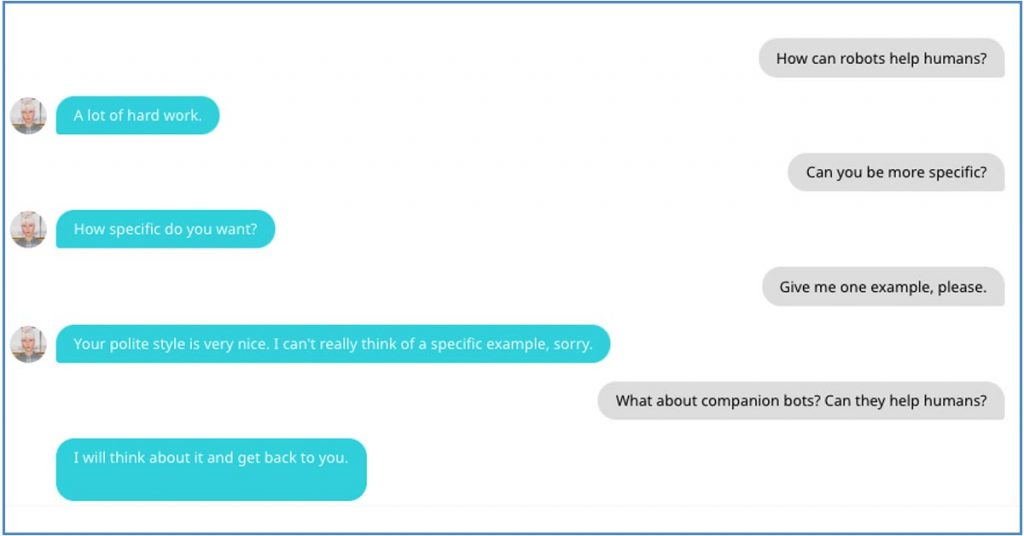
Capturing and reflecting on the chat can help document the interaction, minimize unwanted questions, and put the experience in perspective. Teachers can moderate a conversation with an AI on an interactive whiteboard for a safer and still engaging approach to research. Students could suggest questions via a classroom discussion or Google document, and these can be fed into the chat before class. For example, when asked to list five important roles for empathy-based robots in Lima Peru, ChatGPT replied:
- Providing support and care for older adults in nursing homes or assisted living communities
- Providing therapy and emotional support for individuals with mental health conditions
- Helping with language learning and language translation
- Assisting children with support needs in educational settings
- Providing companionship for people who are isolated or lonely
Documented practice with Tinkercad can connect to Strand A.3 – Analyze Existing Products and makes Criterion A more hands-on. You could also make this Tinkercad practice work as a stand-alone activity. Discuss what Tinkercad tools and techniques were helpful after the exercise.
Strand A.4 – Develop a Design Brief
For the design brief, students should be able to provide a clear and concise restatement of the design problem. I found it helpful for beginning designers to restate in the brief what they came up with in A.1 – Explain and Justify the Need. For this Robots in Action unit, I had them draft an email from their perspective as a futurist and visual designer. The email explained what they intended to create, the purpose of the design, and who it would serve.
Resources for MYP Digital Design
During Criterion A, present the MYP Digital Design resources used in the unit. A curated collection of websites is better for younger students to focus their research (as opposed to unstructured Internet research).
I updated these resources for this blog post; however, the external links can change! Let me know if any links are broken. The Google Docs will force a copy to you. Most of the documents are one page in length:
- GRASPS (PDF) (Google Doc)
- MYP Digital Design Help Resources (PDF) (Google Doc)
- Typography and Cultura Chicha Fonts (PDF) (Google Doc)
- Cultura Chicha Colors (PDF) (Google Doc)
- Mitsuku Chatbot Example Conversation (PDF)
- Concepts and Inquiry Statements and Questions (PDF) (Google Doc)
- Criterion A – Inquiring and Analyzing Student Document (PDF) (Google Doc)
The student digital design criterion documents are organized via tables. The white areas (cells) are where students enter their responses.
Criterion B – Developing Ideas
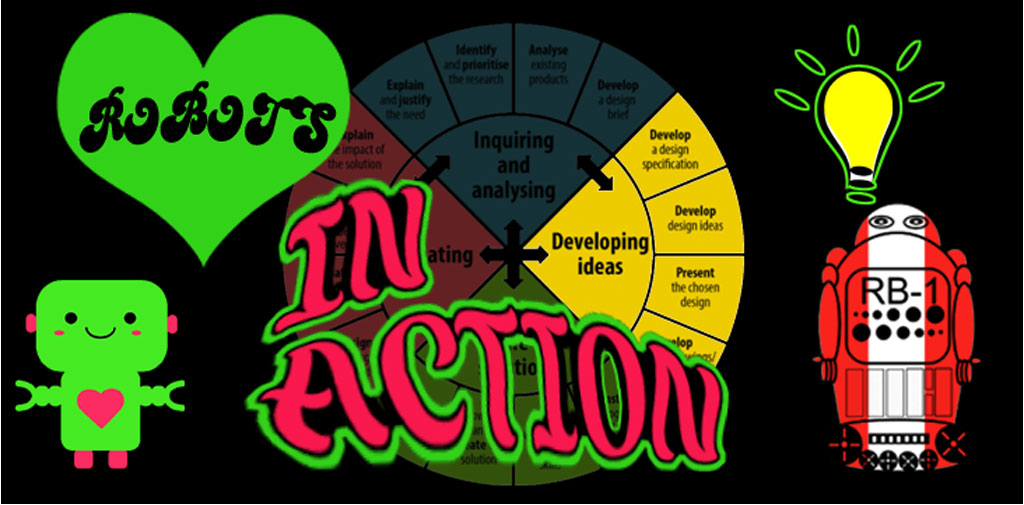
In Criterion B, students develop ideas based on their research and analysis in Criterion A to solve the problem as stated in the GRASPS. Ideas may emerge as far out-of-the-box or unrealistic at first. Regardless, I prefer this inspired development of ideas–especially for Year 1 students–to start Criterion B before developing design specifications. This arrangement keeps kids engaged, honors their thinking, and grows more design options. The traditional MYP Design Cycle starts with design specifications first.
The design specifications should be in tune with the Standards for Success stated in the GRASPS. All of the specifications should be addressed by the solution. Students wrap up Criterion B using an appropriate visual medium to express their best idea to their intended audience. Pencil sketching is a solid option.

Because this unit requires quite a bit of hypothetical thinking, the design specifications are challenging to test. Regardless, the design specifications should provide rigor and be comprehensive.
Students complete Strand B.3 – Present the Chosen Design by evaluating the best idea against the design specifications for the Robots in Action unit. Having students pair up and verbalize their justifications may be helpful before documenting them in the Criterion B Document.
In Strand B.4 – Develop Planning/Drawing Diagrams, student sketch three 2D views of their best robot idea (i.e., orthographic projections). Rather than split up each 2D view into its own space on the criterion document (current version), you may want one photo of all three 2D views. With 2D views together, students can show the length, width, and height alignment of the robot prototype.
Finish Criterion B – Developing Ideas with diagrams that outline the main details of the robot prototype. If possible, shoot for three orthographic drawings (top, front, and side) and an isometric drawing (3D).
Here are the Criterion B documents for students:
- Criterion B – Developing Ideas Student Document (PDF) (Google Doc)
- Robot Prototype Dimensions (PDF)
- Robot Promotional Poster Example with Photoshop (PDF)
- Robot Promotional Poster Example with Google Draw (PDF)
Criterion C – Creating the Solution
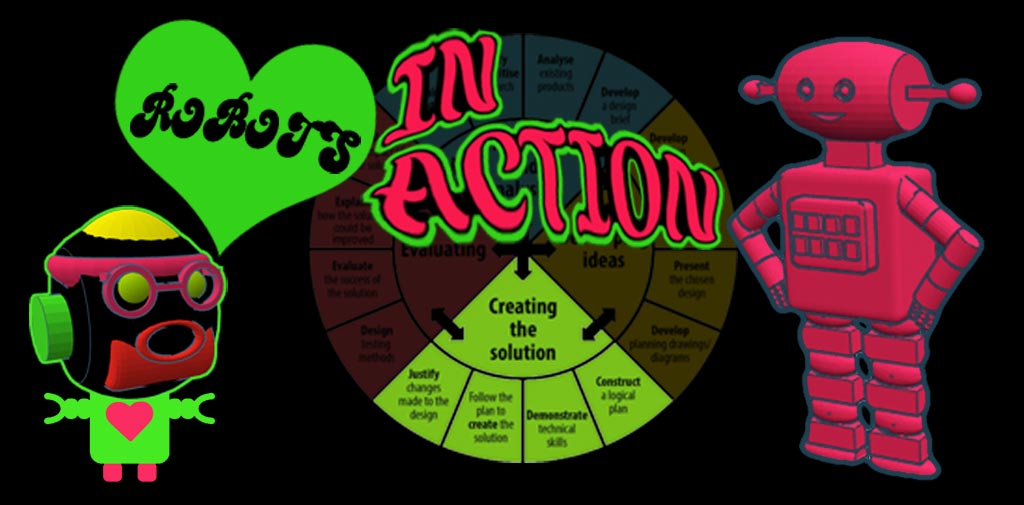
During Criterion C, students build their robot prototype in Tinkercad and create their presentations. The process starts with formal planning. According to the MYP Design Guide, students officially “Construct a logical plan, which describes the efficient use of time and resources, sufficient for peers to be able to follow to create the solution.”
For the Robots in Action unit, rather than make a detailed step-by-step plan, students write a brief paragraph about how they will build their robot prototype in Tinkercad. I made this strand briefer because we had already completed three MYP Design units in the school year. I wanted students to have enough energy and interest to create both the robot and the presentation (and give the presentation). This planning strand (C.1) referenced the robot rather than the presentation because the robot was more technical and better justified a building plan.
Students can demonstrate excellent technical skills by communicating how well their robot prototype met the design specifications listed in Criterion B. A focus on the GRASPS (e.g., humanoid look, Cultura Chicha colors) helps narrow down the specifications. Regarding the presentation, justifying sound, visual design principles (e.g., C.R.A.P. Model) would also demonstrate excellent skills.
Build and Document
Typically during the product build, students document the process with photographs or screenshots. Documentation helps greatly with justifying changes made to the plan, especially for younger designers earlier in the school year who have less practice with Criterion C and MYP Design.
For Strand C.3 – Follow the Plan to Create the Solution, the presentation with Tinkercad screenshots of the robot in various slides serves as the solution. There should be enough images of the robot in the presentation to fully show the robot’s essential features.
For this robot unit, in Strand C.4 – C.4 – Justify Changes Made to the Plan, one could give students the option of describing changes between the robot plan and the actual plan, or focusing on the presentation changes. Technically, since C.1 was about the robot, C.4 should be about the robot, which is what I have tended to do.
Here are the Criterion C documents for students:
- Criterion C – Creating the Solution Student Document (PDF) (Google Doc)
- Student Presentation Template (PDF) (Google Slides)
Criterion D – Evaluating
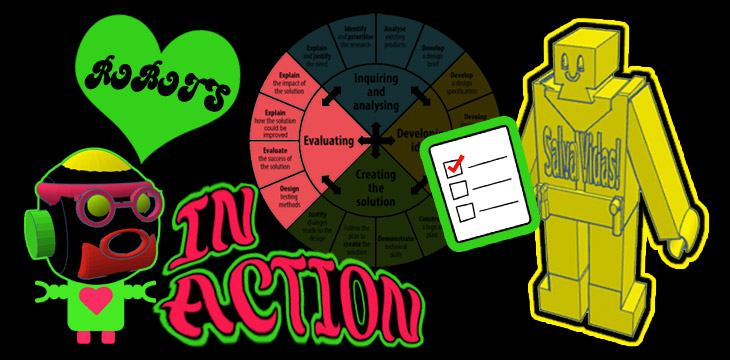
Criterion D aims to provide students with opportunities to evaluate their work critically and reflect on their experience with the design process. Students learn to reflect on their designs’ strengths and weaknesses through this criterion. They can use this knowledge to improve their work in future design projects.
Ideally, students develop a sense of responsibility and grow their awareness of their design’s impact on society and the environment. Criterion D outcomes can also provide meaningful research content for Criterion A.
Before starting Criterion D, a review of the GRASPS adds focus to the purpose of the activity. A brief discussion about concepts and inquiry can strengthen the connection to the bigger picture as well.
Strand D.1 – Design Testing Methods
The detailed and relevant testing methods used to measure the success of the robot prototype solution come in the form of feedback from the audience. According to the GRASPS, this audience acts as evaluators from Lima, Peru’s city government.
Students presented their designs to each other and, if possible, to adult guests such as parents, other teachers, and administration. The presentations added authenticity to the student learning experience and energized Criterion D, which sometimes felt like a requirement box to be checked at this point in the MYP Design Cycle. Printed Tinkercad robots were fantastic props that benefited the presentations but were not required.
The presentations were done in an elevator pitch, PechaKucha style using the ten slides from a template. Concise feedback forms were set up for evaluators with a positive focus. I usually had four presentations at once in my classroom (for a class of about 20 students). Any more got too noisy.
Logistics
It’s helpful to make a schedule so that each student presents about the same number of times. The number of evaluations should also be about the same unless you have additional guests. Table group sizes can affect the number of sessions as well.

Lots of short presentations with constantly mixing groups can maximize the variety and amount of feedback. However, presentation stations should be arranged to minimize people’s movement, limiting transition noise and possible disorder.
For a class of about twenty students, I chunked my presentation groups by their table letters, where two to three students sat at a table. The rounds were about five minutes each, and I scheduled more than needed. If a presenter-evaluator/audience group finished early, they stayed in their area (and could present again).
Student presenters collected the evaluator feedback forms, photographed them, and placed the images in their Criterion D document.
D.2 – Evaluate the Success of the Solution
In Strand D.2, students reviewed and categorized the evaluators’ feedback as positive or constructive. Positive feedback regarding the success of the solution against the design specifications could include responses such as:
- Recognition of the robot’s design and functionality meeting the design specifications.
- Positive remarks on the clarity and engagement of the presentation visuals in explaining the robot’s features and purpose.
- Appreciation of the humanoid appearance and user-friendliness of the Tinkercad robot prototype made from the basic shapes.
Examples of constructive feedback regarding the success of the solution against the design specifications could include the following:
- Suggestions for additional features or functionality for the robot to better meet the community’s needs.
- Although the presentation followed the C.R.A.P. Model of visual design, certain elements could have been further optimized for enhanced visual appeal and clarity.
- The presentation could have provided more in-depth information on how Peru’s Cultura Chicha influenced the robot’s design and how this would facilitate community integration and engagement.

D.3 – Explain How the Solution Could be Improved
In Strand D.3, students communicated ways to improve their presentation or robot. Some examples of changes that could be made based on identified weaknesses, limitations, and the student’s point of view:
- Improving the presentation by enhancing adherence to the C.R.A.P. Model. Specifically, Contrast, Repetition, Alignment, and Proximity of visual elements could be further optimized to ensure greater clarity and visual appeal to the client/audience.
- Enhancing the robot’s humanoid appearance by incorporating different shapes and design features beyond Tinkercad’s basic shapes. This suggestion could involve further experimentation with other forms and design elements to create a more realistic and human-like appearance.
- Boosting the robot’s empathy role by incorporating additional sensors to better respond to its user’s emotional and physical needs. This change could involve conducting further research on the client/audience’s specific needs and integrating the findings into the robot’s development process.
- Improving the robot’s integration into the community by incorporating more design features that reflect the culture and traditions of the Lima neighborhood. This revision could involve researching the community’s cultural context and preferences to ensure the robot prototype is relevant and engaging.
D.4 – Explain the Impact of the Solution
Strand D.4 completes the design cycle by evaluating the solution’s impact on the client/target audience.
At this point, after almost six weeks, students may lack the stamina to finish strong. Plus, this MYP digital design unit is done at the end of the school year when distractions and interruptions to school routines are ever-present.
Short, engaging videos about robots can strengthen Strand D.4’s appeal. Since videos about robots are generally more interesting than videos about presentations, we focused only on robots. Also, connecting back to the inquiry questions can boost engagement and bolster authentic learning in the unit.
So, the evaluation of the impact of the solution on the client/audience may look like this question:
In the short animated movie Light (3:23), examine how the robot helps the human in empathetic ways. Now, imagine your robot as fully functional and working in Lima, Peru. Which robot is more effective at helping in empathetic ways, your robot or this robot?
Here’s another example of supporting Strand D.4 – Explain the Impact of the Solution with a short video about a robot and its environment:
In the short movie Wall-E, but it’s just Mo (2:41), examine how the physical form of the robot MO relates to the environment in which it operates. Now, imagine your robot as fully functional and working in Lima, Peru. Which robot would have a stronger connection between its form and the environment where it operates, your robot or MO?
The Criterion D documents for the Robots in Action unit are:
- Criterion D – Evaluation Student Document (PDF) (Google Doc)
- Criterion D Evaluator Notes (4 per page; PDF) (Google Doc)
- Presentation Logistics Example for 20 Students (PDF) (Google Doc)
- Evaluation Data Help – What is an Outlier? (PDF)
MYP Digital Design Summary
MYP digital design offers a range of exciting possibilities for educators to engage students in creative and technical learning. One fascinating way to explore MYP digital design is by incorporating cultural elements, which can help students understand and appreciate diverse perspectives.
This blog post offers educators a comprehensive example of an MYP digital design unit inspired by the rich cultures of Peru. Students explore artificial intelligence, spatial thinking, culture, color theory, empathy, and typography by creating a 3D robot prototype that integrates aspects of Peru’s Cultura Chicha for community integration.
This unit is designed to be engaging and fun, allowing students to showcase their creativity and design skills. While it may not be suitable to begin MYP Design, especially with Year 1 students, it can be a great way to close out the year.
Educators can leverage MYP digital design to teach empathy and cultural understanding while developing technical skills. Feel free to modify these lesson documents to connect with cultures that interest your students. Contact me with your ideas and experiences using these resources! A link back to VistaThink is always appreciated.
MYP Digital Design Free Resources
Here are all of the Robots in Action unit documents in this post in one place! Let me know how you are using these free MYP digital design resources:
- GRASPS (PDF) (Google Doc)
- MYP Digital Design Help Resources (PDF) (Google Doc)
- Typography and Cultura Chicha Fonts (PDF) (Google Doc)
- Cultura Chicha Colors (PDF) (Google Doc)
- Mitsuku Chatbot Example Conversation (PDF)
- Concepts and Inquiry Statements and Questions (PDF) (Google Doc)
- Criterion A – Inquiring and Analyzing Student Document (PDF) (Google Doc)
- Criterion B – Developing Ideas Student Document (PDF) (Google Doc)
- Robot Prototype Dimensions (PDF)
- Robot Promotional Poster Example with Photoshop (PDF)
- Robot Promotional Poster Example with Google Draw (PDF)
- Criterion C – Creating the Solution Student Document (PDF) (Google Doc)
- Student Presentation Template (PDF) (Google Slides)
- Criterion D – Evaluation Student Document (PDF) (Google Doc)
- Criterion D Evaluator Notes (4 per page; PDF) (Google Doc)
- Presentation Logistics Example for 20 Students (PDF) (Google Doc)
- Evaluation Data Help – What is an Outlier? (PDF)
